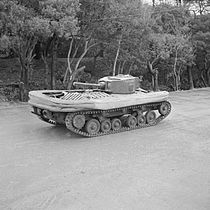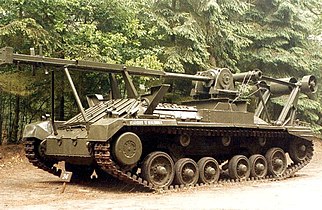Valentine tank
| Tank, Infantry, Valentine, Mk I–XI | |
|---|---|
 Valentine II atPatriot Park,Russia | |
| Type | Infantry tank |
| Place of origin | United Kingdom |
| Service history | |
| In service | 1940–1960 |
| Used by | British Army,Red Army,New Zealand Army |
| Wars | World War II 1948 Arab–Israeli War Cyprus crisis of 1963–64 |
| Production history | |
| Designer | Vickers-Armstrongs |
| Designed | 1938 |
| Manufacturer | Vickers-Armstrongs and others |
| Produced | 1940–1944 |
| No.built | 8,275 (6,855 built in UK and 1,420 in Canada) |
| Specifications | |
| Mass | about 16 long tons (16 t) |
| Length | hull: 17 ft 9 in (5.41 m) |
| Width | 8 ft 7.5 in (2.629 m) |
| Height | 7 ft 5.5 in (2.273 m) |
| Crew | Mk I, II, IV, VI–XI: 3 (Commander, gunner, driver) Mk III, V: 4 (+ loader) |
| Armour | 0.31–2.56 in (8–65 mm) |
Main armament | Mk I–VII:QF 2-pounder(40 mm) Mk VIII–X:QF 6-pounder(57 mm) Mk XI:QF 75 mm Mk IIICSQF 3-inch (76 mm) |
Secondary armament | Mk I–VII, X, XI: 7.92 mmBESA machine-gunwith 3,150 rounds |
| Engine | Mk I:AECA189 9.6 litrepetrol Mk II, III, VI: AEC A190diesel Mk IV, V, VII–XI:GMC 6004 diesel 131–210hp(97–157 kW) |
| Power/weight | 12.4 hp (9.2 kW) / tonne |
| Transmission | Meadows Type 22 (5 speed and reverse) |
| Suspension | modified three-wheelHorstmann suspension"Slow Motion" |
| Fuel capacity | 36 gallons internal |
Operational range | 90 mi (140 km) on roads |
| Maximum speed | 15 mph (24 km/h) on roads |
Steering system | clutch and brake |
TheTank, Infantry, Mk III, Valentinewas aninfantry tankproduced in theUnited KingdomduringWorld War II.More than 8,000 of the type were produced in eleven marks, plus various specialised variants, accounting for approximately a quarter of wartime British tank production.[1]The many variants includedrivetedand welded construction, petrol and diesel engines and a progressive increase in armament. It was supplied in large numbers to theUSSRand built under licence in Canada. It was used extensively by the British in theNorth African campaign.Developed by Vickers, it proved to be both strong and reliable.[1][2]
Name[edit]
There are several proposed explanations for the nameValentine.According to the most popular one, the design was presented to theWar OfficeonSt Valentine's Day,14 February 1940, although some sources say that the design was submitted on Valentine's Day 1938 or 10 February 1938.[1][3][4]White notes that "incidentally" Valentine was the middle name ofSir John Carden,the man who was responsible for many tank designs including that of the Valentine's predecessors, the A10 and A11.[5][a]Another version says that Valentine is anacronymforVickers-ArmstrongsLimitedElswick&(Newcastle-upon) Tyne.The "most prosaic" explanation according to authorDavid Fletcheris that it was just an in-house codeword of Vickers with no other significance.[6]
Development[edit]
The Valentine started as a proposal based on Vickers' experience with theA9andA10specification cruiser tanks and theA11(Infantry Tank Mk I). As a private design by Vickers-Armstrongs, it did not receive a General Staff "A" designation; it was submitted to the War Office on 10 February 1938. The development team tried to match the lower weight of acruiser tank,allowing the suspension and transmission parts of the A10 heavy cruiser to be used, with the greaterarmourof aninfantry tank,working to a specification for a 60 mm (2.4 in) armour basis (the same as the A.11).[7][b]
The tank was to carry a 2-pounder gun in a two-man turret (the A.11 was armed only with a heavy machine gun), a lower silhouette and be as light as possible, resulting in a very compact vehicle with a cramped interior. Compared to the earlierInfantry Tank Mk II "Matilda",the Valentine had somewhat weaker armour and almost the same top speed. By using components already proven on the A9 and A10, the new design was easier to produce and much less expensive.[9]
The War Office was initially deterred by the size of the turret, since they considered a turret crew of three necessary, to free the vehicle commander from direct involvement in operating the gun.[10]Concerned by the situation in Europe, it finally approved the design in April 1939 and placed the first order in July for deliveries in May 1940. At the start of the war, Vickers were instructed to give priority to the production of tanks.[11]The vehicle reached trials in May 1940, which coincided with the loss of much of the army's equipment in France, duringOperation Dynamo,the evacuation from Dunkirk. The trials were successful and the vehicle was rushed into production as "Tank, Infantry, Mark III"; no pilot models were required as much of the mechanics had been proven on the A10,[12]and 109 had been built by the end of September.[13]During late 1940 and early 1941, Valentines were used in thecruiser tankrole in British-based armoured divisions, and they were supplied to tank brigades of theEighth ArmyinNorth Africafrom June 1941.[14]
Production[edit]

Metropolitan-Cammell Carriage & Wagon—an associate company of Vickers—andBirmingham Railway Carriage & Wagon Company(BRCW) were contracted to produce the Valentine. Metropolitan and the BRCW had built small numbers of the A10, their production runs were just finishing and they delivered their first Valentines in mid-1940. Metropolitan used two sites, withWednesburyjoined by their Midland site in production of the Valentine. Vickers output started at ten per month rising to 45 per month in a year and peaking at 20 per week in 1943, before production was slowed and then production of the Valentine and derivatives stopped in 1945. Vickers-Armstrong produced 2,515 vehicles and Metropolitan 2,135; total UK production was 6,855 tanks,[15]with 2,394 exported from Britain to theSoviet Unionunderlend-lease.[16]
To develop its own tank forces,Canadahad established tank production facilities. An order was placed in 1940 with Canadian Pacific and after modifications to the Valentine design to use local standards and materials, the production prototype was finished in 1941.[17]Canadian production was mainly atCPR Angus ShopsinMontrealand 1,420 were produced in Canada,[18]of which 1,388 were sent to the Soviet-Union. They formed the mainCommonwealthexport to the Soviet Union under lend-lease. The remaining 32 were retained for training.[16]The use of local GMCDetroit Dieseltwo-stroke enginesin Canadian production was a success and the engine was adopted for British production. British and Canadian production totalled 8,275, making the Valentine the most produced British tank design of the war.[11]
Vehicle layout[edit]
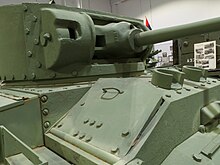
The Valentine was of conventional layout, divided internally into three compartments; from front to back the driver's position, the fighting compartment with the turret and then the engine and transmission driving the tracks through rear sprockets. The driver's area contained only the driver and the driving controls. The driver sat on hull centre line, entering through either of two angled hatches over the seat, though there was an emergency exit hatch beneath his seat. The driver had a direct vision port—cut in what was one of the hull cross members—in front of him and two periscopes in the roof over his head. Driving was by clutch and brake steering through levers, whose control rods ran the length of the hull to the transmission at the rear.[19]
Behind the driver was a bulkhead that formed another hull cross-member and separated him from the fighting compartment. The first tanks had a two-man turret, the gunner on the left of the gun and the commander acting also as the loader on the right. When three-man turrets were introduced, the commander sat to the rear of the turret. The turret was made up of a cast front and a cast rear riveted to the side plates which were of rolled steel.[20]All tanks carried the radio in the turret rear. Early tanks used theWireless set No. 11with aTannoyfor the crew; later tanks hadWireless Set No. 19,which included crew communications with long and short range networks.[20]

Turret rotation was by electric motor controlled by the gunner, with a hand-wheel for manual backup. The restrictions that the two-man turret placed on the commander, made more so if they were atroopcommander and responsible for directing the actions of two other tanks besides their own, were addressed by enlarging the turret for the Mark III so that a loader for the main armament could be carried. The turret ring diameter was not changed, so the extra space was found by moving the gun mounting forward in an extended front plate and increasing the bulge in the rear of the turret. This increased weight by half a ton on the 2.5 long tons (2.5 t) two-man turret.[21]
A bulkhead separated the fighting compartment from the engine compartment. The engine, clutch and gearbox were bolted together to form a single unit. The first Valentines used a petrol engine and the diesel engine which distinguished the Mark II—at the time Tank Infantry Mark III*— from the Mark I, was based on the AEC Comet, a commercial road vehicle engine. The Mark IV used a GMC Detroit Diesel; these were the majority of those used in the desert campaigns. The gearbox was a 5-speed, 1-reverseMeadowsconnected to the multiplate steering clutches which then fed epicyclic reduction gearboxes on the sides of the tanks. The brakes themselves were on the outside of the drive sprockets.[20]The suspension was made up of two units on either side; each unit made up of a single 24 in (0.61 m) diameter wheel and two19+1⁄2in (0.50 m) wheels. Improved tracks were added to later marks.[20]
Combat history[edit]
North Africa[edit]
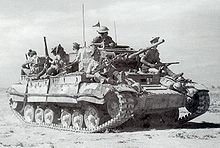
The Valentine was extensively used in theNorth African Campaign,earning a reputation as a reliable and well-protected vehicle.[22]The first Valentines went into action in December 1941 with the8th Royal Tank RegimentinOperation Crusader.[23]The tank first served in Operation Crusader in the North African desert, when it began to replace the Matilda Tank. Due to a lack of cruisers, it was issued to armoured regiments in the UK from mid-1941.[22]The Valentine was better armed and faster than theCruiser Mk II.During the pursuit fromEl Alameinin late 1942, some tanks had driven more than 3,000 miles (4,800 km) by the time theEighth Armyreached Tunisia.[23]

The Valentine shared the common weakness of the British tanks of the period in that its 2-pounder gun lacked high-explosive (anti-personnel) ammunition and soon became outdated as an anti-tank weapon. Introduction of the 6-pounder in British service was delayed until the loss of equipment inFrancehad been made good, so the 2-pounder was retained longer.[23]
The small size of the turret and of the turret ring meant that producing mountings for larger guns proved a difficult task. Although versions with the 6-pounder and then with theOrdnance QF 75 mm gunwere developed, by the time they were available in significant numbers, better tanks had reached the battlefield. Another weakness was the small crew compartment and the two-man turret. A larger turret, with a loader position added, was used in some of the 2-pounder versions but the position had to be removed again in variants with larger guns. Its relatively low height was an advantage in a battlefield with little cover, allowing it to take up a "good hull-down position in any convenient fold in the ground".[23]
Madagascar[edit]
Six Valentines of 'B' Special Service Squadron of theRoyal Armoured Corpstook part in the 1942Battle of Madagascarwith sixTetrarchsof 'C' Special Service Squadron.[24]
Northwest Europe[edit]
By 1944, the Valentine had been almost replaced in front-line units of theEuropean theatreby theChurchill tank(the Infantry Tank Mark IV) and the US-madeM4 Shermantank. A few were used for special purposes or as command vehicles for units equipped with theArcherself-propelled gun. The Royal Artillery used the Valentine XI (with 75 mm gun) as an OP command tank until the end of the war.[17]
Pacific[edit]
In thePacific War,25 Valentine Mk III and nine Valentine Mk IIICS tanks were employed by the3rd New Zealand Divisionin the south-west Pacific campaign. Trials in New Zealand had found that the locally developed 2 pounder HE shell lacked power, especially compared to the 18-pounder shell of the 3-inch howitzer, so 18 Valentine Mk III were converted to Valentine Mk IIICS standard by having their main armament replaced by theQF 3-inch howitzertaken from Matilda Mk IVCS tanks, surplus to New Zealand requirements. Other modifications to the nine Valentine Mk IIICS tanks deploying to the Pacific included Infantry telephones (a means for infantry to talk to the tank commander). The converted tanks carried 21 HE and 14 smoke shells. The other nine 3-inch armed tanks and 16 normal Valentines (with 2-pounder guns) remained in New Zealand for training. The Valentine was retired from New Zealand service in 1960.[25]
Eastern Front[edit]
This sectionneeds expansionwith: section. You can help byadding to it.(November 2010) |

Valentines, of all Marks except the Mark I, were sent to the USSR from 1941. The creation of Valentines tanks destined for use by the Soviet Union was a part of a campaign known asAid to Russia Fund,headed byClementine Churchilland heavily supported by theCommunist Party of Great Britain.In Soviet service, the Valentine was used from theBattle of Moscowuntil the end of the war, mainly in the second line. Although criticised for its low speed and the 2-pounder gun, the Valentine was liked due to its small size, reliability and good armour protection. Initially the tracks gave some problems in winter; from freezing down to minus 20, snow packed into the tracks, though at below minus 20 it was not a problem. The problem was later solved.[26]

Soviet Supreme Command asked for its production until the end of the war. In August 1945, as part of theSoviet invasion of Manchuria,the 267th Tank Regiment (40 Valentine III and IX) of the59th Cavalry DivisionRed Army, together with the 65thT-34-8543rd Tank Brigade, passed from EasternGobiacross the mountainsGreater KhingantoKalganinChina.[27][28][29]
Cyprus[edit]
The last use of a Valentine in combat is thought to have occurred during theCyprus crisis of 1963–64.A turretless Valentine from a quarry was used by Greek militia, fitted with an improvised armoured casemate from which a gunner could fire aBren gun.The vehicle is owned by theCypriot National Guard,who intend to place it in a proposed new military museum.[30]
Variants[edit]

Valentine I(Tank, Infantry, Mk III): (308)
- The first model of the Valentine; production was by Vickers, Metro-Cammell and Birmingham Railway[12]The tank had a riveted hull, was powered byAECA189 135 hp petrol engine and equipped with a 2-pounder gun and a coaxialBesa machine gun.Its two-manturretforced the commander to act as the loader.
Valentine II(Tank, Infantry, Mk III*): (700)
- Until the Valentine name adopted in June 1941, known as "Tank, Infantry, Mark III*".[20][c]This model used AEC A190 131 hp 6-cylinderdiesel engine.To increase its range in the desert, an auxiliary jettisonable external fuel tank was installed to the left of the engine compartment.

Valentine III
- Modifications to the turret design – moving the front turret plate forward and a larger rear bulge – gave room for a loader to ease the duties of the commander.[31][page needed]The side armour was reduced from 60 mm (2.4 in) to 50 mm (2.0 in) to save weight.[citation needed]
Valentine IIICS(Close Support)
- New Zealand modification of 18 Valentine III carried out by replacing the 2 pounder with a 3 "Howitzer from Matilda IVCS tanks.[32][page needed]They were used in Guadalcanal in the Solomon Islands (seeBattle of the Green Islands), and remained in service into the 1950s.[33]
Valentine IV
- A Mark II using an American 138 hpGMC 6004 dieselengine and US-made transmission. Though it had slightly shorter range, it was quieter and highly reliable.[d]
Valentine V
- As the Valentine III but with theGMC 6004 dieseland US-made transmission.
Valentine VI
- Canadian-built version of Mk IV; initially known as Tank, Infantry Mark III***.[31][page needed]It used some Canadian and American mechanical parts and a GMC diesel engine. Late production vehicles had castglacisdetail, along with more use of cast sections instead of fabricated ones. The first fifteen were produced with a 7.92 mm Besa coaxial machine-gun, thereafter replaced by a coaxial 0.30-inchBrowning machine-gun.

Valentine VII
- Another Canadian version, it was essentially the VI with internal changes and No. 19 Wireless replaced the No. 11 radio set.
Valentine VIIA
- Mark VII with jettisonable fuel tanks, new studded tracks, oil cooler and protected headlights.
Valentine VIII
- AEC diesel engine and turret modification to take 6-pounder gun; meant the loss of the coaxial machine-gun. Never built due to being inferior to Mk IX.[34]
Valentine IX
- A V upgraded to the 6-pounder gun as VIII. Similar armour reduction as on the Mk VIII; on late production units an upgraded, 165 hp version of the GMC 6004 diesel was installed, somewhat improving mobility.

Valentine X(135)
- New turret design so that a Besa coaxial machine-gun could be mounted again. Welded construction; the 165 hp engine was used in place of the 130 hp engine in some production.[35]
Valentine XI
- An X upgraded with theOQF 75 mmgun and 210 hp version of the GMC 6004 diesel; welded construction. The Canadian cast nose introduced into British production, only used as a command tank.[35]
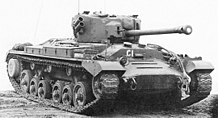
Valentine DD
- Valentine Mk V, IX and Mk XI, made amphibious by the use ofNicholas Straussler's "Duplex Drive".Conversions by Metro-Cammell of 625 tanks delivered in 1943–1944. Used by crews training for theM4 ShermanDD tanks for theNormandy Landingsas well as training in Italy and India. A few were used in Italy in 1945.[36]
Valentine OP / Command
- Artillery Observation Post and Command Vehicle; extra radios, to give more space inside, the gun was removed and a dummy barrel fitted to the front of the turret. Used by battery commanders and observation post for Archer units.
Valentine CDL
- Continuation ofCanal Defence Lightexperiments; conventional turret replaced with one containing a searchlight.
Valentine Scorpion II
- Mine flail;turretless vehicle with flail attachment never used operationally.
Valentine AMRA Mk Ib
- ArmouredMine RollerAttachment, a few used on the beaches of Normandy during D-Day.
Valentine Snake
- Mine exploder; using "Snake"mine-clearing line chargeequipment; a few used operationally.
Valentine Bridgelayer
- Armoured bridgelaying vehicle;a turretless Mk II fitted with 10 m (34 ft) long by 2.90 m (9 ft 6 in) wide Class 30 (capable of bearing 30 long tons (34 short tons)) scissors bridge. 192 were produced,[37]25 of them supplied to the USSR.[16]Used in action in Italy, Burma,north-west Europeand Manchuria.
Valentine with 6-pounder anti-tank mounting
- Experimental vehicle built byVickers-Armstrongto examine the possibility of producing a simple tank destroyer by mounting the 6-pounder in its field carriage on the hull in place of the turret. Trials only, 1942 not required since the Valentine could be fitted with a 6-pounder in a turret.[38]
Valentine flame-throwers
- Two Valentine tanks were modified to carry flame-throwers and were tested by thePetroleum Warfare Departmentto determine which system was best for a tank-mounted flame projector. One used a projector pressurised by slow burning cordite charges (designed by the Ministry of Supply) and one designed by AEC with the PWD using a projector operated by compressed hydrogen gas.[39][38]Both carried the flame-thrower fuel in a trailer and the flame projector was mounted on the hull front. Trials started in 1942 and showed that the gas-operated system was better. From this test installation was developed the Crocodile equipment for the Churchill Crocodile flame-thrower used in the North West Europe campaign in 1944–45.[39]
Valentine 9.75-inch flame mortar
- Experimental vehicle with the turret replaced by fixed heavy mortar intended to fire 25 lb TNT incendiary shells to demolish concrete emplacements. Trials only by the Petroleum Warfare Dept, 1943–45. Effective range was 400 yd (370 m) (maximum range 2,000 yd (1,800 m)). Few used in Normandy on D-Day to help clear buildings.
Burmark
- "Ark" design using Valentine hull for a light ramp tank to be used in Far East. The end of the war precluded further development.[36]
Gap Jumping Tank
- Experiments with rockets late in the war to propel a Valentine tank across an obstacle such as a minefield.[36]
Gallery[edit]
-
Valentine flame-thrower (gas-operated equipment)
-
Flame mortar fitted to Valentine tank chassis, firing phosphorus bombs
-
Valentine DD tank with screen lowered, 1944
-
Valentine with AMRA
-
Valentine Scorpion
Operators[edit]
- Canadian Armyreceived 30 of 1,420 tanks built in Canada. Valentines were used for training purposes.
- 11th Infantry Battalionrepaired two Valentine wrecks in Tobruk.
- 1st Czechoslovak Independent Armoured Brigade Groupreceived Valentines in spring 1943. These tanks were the first ones officially operated by the Czechoslovak exile army in WWII.
- Egyptian Armyused Valentine tanks after WWII; used inMandatory Palestineduring1948 Arab–Israeli War,then relegated to training.[40]
- Imperial Iranian Ground Forcesreceived some ex-Lend Lease tanks from the USSR after WWII.
- Captured Valentines were pressed into service with theAfrika Korpsand were designatedInfanterie Panzerkampfwagen Mk III 749 (e).[41][page needed]
- New Zealand received[42]
- 100 Valentine II
- 75 Valentine III, 18 converted to Valentine IIICS
- 81 Valentine V
- 11 Valentine Bridgelayers
- Polish 1st Armoured Divisionand various other units ofPolish Armed Forces in the Westoperated Valentine tanks for training.
- ThePortuguese Armyreceived 36 Valentine Mk II in 1943, which were used by theBatalhão de Carros(Infantry Tank Battalion).
- Romanian Armycaptured four Mk III tanks from the Red Army, which were used for testing and anti-tank training.[43]
- Red Armyreceived 2,124 British-built and 1,208 Canadian-builtLend-Leasetanks. 270 and 180 lost during transportation.[44]
- TheTurkish Armyreceived 200 Valentine IIIs between 1941 and 1944.[45]
Vehicles based on Valentine chassis[edit]
- SP 17-pounder, Valentine, Mk I, Archer
- Carrier, Valentine, 25-pounder gun Mk I, Bishop
- Tank, Infantry, Valiant (A38)
Surviving tanks[edit]
-
Tank no 838 at the Canadian War Museum
-
Valentine Bridgelayer (without bridge)Overloon War Museum,1987
-
Valentine Bridgelayer,Kubinka Tank Museum,2009
-
ValentineCavalry Tank Museum, Ahmednagar,2014
-
Valentine MK IX at the Bovington Tank museum, 2009
Around forty Valentine tanks and vehicles based on the Valentine chassis survive. Tanks in running condition are at theBovington Tank Museum(Mark IX) and in private hands in New Zealand and the United Kingdom.[30]The Bovington collection has a Mark II and a Valentine Scissors Bridgelayer. Other examples are displayed at theImperial War Museum Duxfordin the UK; theRoyal Military Museumin Brussels, Belgium; theMusée des Blindés,Saumur, France and the Kubinka Tank Museum, Russia; theSouth African National Museum of Military History.In the United States, theMilitary Vehicle Technology Foundationand the Virginia Museum of Military Vehicles own Valentines.
The Cavalry Tank MuseumAhmednagar,India have a Valentine Tank and a Valentine Bridgelayer.[30]
A number of Valentine hulls are in private ownership in Australia, including one in theAustralian Armour and Artillery Museum.These were sent there after the war for use as agricultural vehicles.[30]
Two Canadian-built Valentines survive. Valentine Tank Mk VIIA, no. 838, built May 1943, was a Lend-Lease tank shipped to the Soviet Union. It fell through the ice of a boggy river nearTelepyne,Ukraine(Russian: Telepino), during a Soviet counter-offensive on 25 January 1944. In 1990 a 74-year-old villager helped locate the tank and it was recovered and offered as aGlasnost-era gift to Canada. It was presented to theCanadian War Museumby independent Ukraine in 1992 and stands on display in the LeBreton Gallery.[46]A Valentine built by Canadian Pacific resides at theBase Borden Military Museumin Barrie, Ontario.
A notable survivor is the only intact DD Valentine. This has been restored to running condition and is in the United Kingdom, privately owned by John Pearson. A number of DD Valentines that sank during training lie off the British coast; several have been located and are regularly visited by recreational divers.[30]Two Valentines lie in theMoray Firthin Scotland and two lie 3.5 miles (5.6 km) out ofPoole Bayin Dorset. These tanks lie 100 m (110 yd) apart in 15 m (49 ft) of water. A further tank is known to lie in around 10 m (11 yd) of water inBracklesham Bay,south of Chichester in West Sussex; the hull and turret are clearly recognisable as it sits on a gravel mound.
In October 2012, a Valentine Mk IX tank that fell through ice while crossing a river in western Poland during the Soviet Army's march to Berlin was recovered. This, the only surviving Valentine Mk IX to have actually seen combat, is reportedly well preserved and could possibly be restored to operational condition.[47]
See also[edit]
References[edit]
Notes
Citations
- ^abcForty 2006,p. 98.
- ^The Tank Museum(24 November 2015)."Tank Chats #11 Valentine | The Tank Museum".YouTube.Retrieved6 December2020.
- ^White 1969,p. 2.
- ^Baryatinskiy 2002,p. 3.
- ^White 1969,p. 1.
- ^Fletcher p43
- ^Newsome 2016,pp. 4–5.
- ^Newsome 2016,p. 5.
- ^Newsome 2016,pp. 3–5.
- ^Fletcher p 45
- ^abWhite 1969,p. 9.
- ^abNewsome 2016,p. 8.
- ^Rickard, John (7 May 2015)."Infantry Tank Mk III – Valentine".historyofwar.org.Retrieved29 May2021.
- ^Chamberlain & Ellis 1969,p. 60.
- ^Newsome 2016,pp. 13–14.
- ^abcBaryatinskiy 2002,p. 19.
- ^abNewsome 2016,p. 17.
- ^Baryatinskiy 2002,p. 13.
- ^White 1969,p. 10.
- ^abcdeWhite 1969,p. 13.
- ^White 1969,p. 14.
- ^abWhite 1969,p. 19.
- ^abcdPerrett 1981,p. 16.
- ^Phillips, Russell (5 May 2021).A Strange Campaign: The Battle for Madagascar.Shilka Publishing.ISBN9781912680276.
- ^Newsome 2016,pp. 17–18.
- ^White p19
- ^Baryatinskiy 2002,p. 22.
- ^Horse-mechanized group TRANS-Baikal front
- ^Hill. 2007, p773–808
- ^abcdePierre-Olivier (7 November 2010)."Surviving Valentines"(PDF).Surviving Panzers website.Retrieved18 November2010.
- ^abWhite 1969.
- ^Plowman 2001.
- ^Cooke 2000,pp. 361–362.
- ^Newsome 2016,p. 9.
- ^abWhite 1969,p. 15.
- ^abcWhite 1969,p. 16.
- ^David Boyd. (31 December 2008)."Valentine Infantry Tank".Archivedfrom the original on 10 August 2011.Retrieved30 June2009.
- ^abWhite 1969,p. 17.
- ^abBanks 1946,p. 75.
- ^Zaloga 1981,pp. 8–9.
- ^Carruthers 2013.
- ^Plowman 1985,p. 132.
- ^Axworthy 1995,p. 221.
- ^Baryatinskiy 2002,p. 18.
- ^Mahé, Yann (February 2011). "Le Blindorama: La Turquie, 1935 - 1945".Batailles & Blindés(in French). No. 41. Caraktère. pp. 4–7.ISSN1765-0828.
- ^Fred Gaffen ed.,Canadian Valentine Tank MK VIIA,Canadian War Museum Fact Sheet No. 5.
- ^Day 2012.
Bibliography
- Axworthy, Mark (1995).Third Axis, Fourth Ally: Romanian Armed Forces in the European war, 1941–1945.London New York, NY: Arms and Armour (Distributed in the USA by Sterling Pub.).ISBN978-1-85409-267-0.
- Banks, Sir Donald(1946).Flame Over Britain.Sampson Low, Marston and Co.OCLC634031734.
- Baryatinskiy, M. (2002).Пехотный танк Валентайн[Valentine Infantry Tank] (in Russian). no isbn. Бронеколлекция: Моделист-Конструктор.
- Carruthers, Bob (2013).Panzers at War 1939–1942.Barnsley, South Yorkshire: Pen & Sword Military.ISBN978-1-78159-130-7.
- Chamberlain, Peter; Ellis, Christopher (1969).British and American Tanks of World War II(2nd US ed.). New York: Arco.ISBN0668043040.
- Cooke, Peter (2000).Defending New Zealand: Ramparts on the Sea 1840–1950s.Wellington: Defence of New Zealand Study Group.ISBN0-473-06833-8.
- Day, Matthew (25 October 2012)."Polish Historians Bid to Dig up British Second World War Tank".The Telegraph.Archived fromthe originalon 28 October 2012.Retrieved25 October2012.
- Fletcher, D. (2006).Swimming Shermans: Sherman DD Amphibious Tank of World War II.New Vanguard 123. Oxford: Osprey.ISBN978-1-84176-983-7.
- Forty, George (2006).The Complete Guide to Tanks & Armoured Fighting Vehicles.London: Hermes House.ISBN978-1-84681-110-4.
- Hill, Alexander (2007). "British Lend Lease Aid and the Soviet War Effort, June 1941 – June 1942".The Journal of Military History.71(3): 773–808.doi:10.1353/jmh.2007.0206.JSTOR30052890.S2CID159715267.
- Newsome, Bruce (2016).Valentine Infantry Tank 1938–45.New Vanguard 233. Oxford: Osprey.ISBN978-1-4728-1375-6.
- Perrett, Bryan (1981).British Tanks in N. Africa 1940–42.Vanguard 23. London: Osprey.ISBN978-0-85045-421-5.
- Plowman, Jeffery (1985).Armoured Fighting Vehicles of New Zealand 1939–59.Somerset Printing.OCLC220159206.
- Plowman, Jeffery (2001).New Zealand Armour in the Pacific 1939–45.ISBN0-473-07503-2.
- White, B. T. (1969).Valentine Infantry Tank Mk III.AFV 6. Windsor: Profile Publishing.OCLC54349409.
- Zaloga, Steven J. (1981).Armour of the Middle East Wars 1948–78.Vanguard 19. London: Osprey.ISBN978-0-85045-388-1.
Further reading[edit]
- Fletcher, David(1989).The Great Tank Scandal: British Armour in the Second World War - Part 1.HMSO.ISBN978-0-11-290460-1.
- Fletcher, David (1989).Universal Tank: British Armour in the Second World War - Part 2.HMSO.ISBN978-0-11-290534-9.
- Hamilton, S. D. (1996).50th Royal Tank Regiment: The Complete History.Cambridge: The Lutterworth Press.ISBN978-0-7188-2938-4.
- Perrett, Bryan (1972).The Valentine in North Africa 1942–43.London: Arms & Armour Press.ISBN978-0-7110-0262-3.
- Taylor, D. (2011).Into the Vally: The Valentine Tank and Derivatives 1938–1960.Green. Poole: Sandomierz: Mushroom Model Publications.ISBN978-83-61421-36-8.



